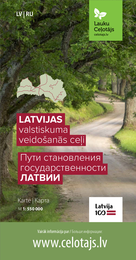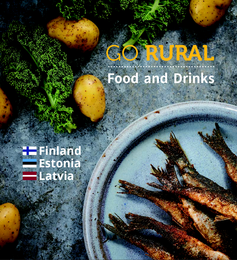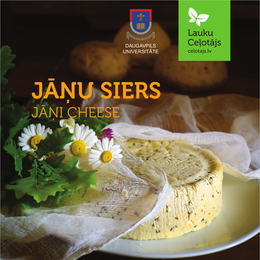Издания
| Lauku ceļotājs регулярно издает каталог мест ночлега «Отдых на селе», карты и путеводители для путешествующих на автомобиле, велосипеде, лодке и пешком. Все наши издания - это практическая информация, которая полезна как во время планирования, так и в течение путешествия. На этой странице, ниже, вы подробнее ознакомитесь с той информацией, которая содержится в каждом из наших изданий. Если вы не можете найти наши издания в книжных магазинах или на АЗС Statoil в Латвии, то вы можете получить бесплатные или приобрести платные издания в бюро Ассоциации, ул. Калнциема, 40, Рига. Для того чтобы на свою электронную почту получать новости от Lauku ceļotājs о новых вышедших картах и путеводителях, а также прочие новинки, отправьте адрес своей электронной почты на lauku@celotajs.lv или свяжитесь с нами по телефону 67617600. Для просмотра новостей на нашей домашней странице следуйте по этой ссылке.
|
| Publication | Description |
|---|---|
"Go Rural" Product manual 2018 - Latvia/Estonia/South coast FinlandThis manual is aimed at helping you discover rural destinations in the South of Finland, Estonia and Latvia beyond traditional touristic routes. The programmes and sites in this manual are based around small-scale accommodation, open farms, local producers, living traditions and sincere people. The people here have a close relationship with their natural surroundings and annual cycle. Each season has its own specific activities like mushrooming, berry picking, collecting herbs, ice-fishing and different agricultural jobs as well as traditional and seasonal celebrations. The countries are a haven for the tourist who loves nature, respects traditions and would like to experience them and their cultures more deeply. Behind this manual there is a team of professional countryside tourism organisations and tour operators. For many years we have carried regular inspections of our accommodation and sites, have closely cooperated with national parks and nature experts, researched and developed new routes. In this brochure we present example products based on rural experiences such as visits to country farms, hands-on workshops, tours of UNESCO World Heritage Sites, stays at spa hotels, and opportunities to get closer to nature or to live like locals. Some model itineraries for touring the three countries are presented. All of these can be linked with the traditional touristic routes and city experiences to bring more variety and attraction. Travelling options between the countries are shown by air, ferries and bus. A list of tour operators that can help to arrange tours and services group and individual customers is provided in this manual. |
|
Пути становления государственности ЛатвииНа карте обозначены семь путей становления государственности Латвии для путешествий. Они приглашают оглянуться на создание латышского государства и повороты в ближнем и дальнем прошлом. Семь путей – это путешествия по Латвии с целью ее познания. Эти пути позволяют ознакомиться с поворотами истории Латвии, личностями, местами и событиями, способствовавшими образованию государства и становлению национальной идентичности, а также и оглянуться на более отдаленное прошлое, вспоминая государственные образования, веками существовавшие на территории Латвии и ставшие частью латышского культурного пространства. В издание включено: Карта Латвии (масштаб 1: 550000) с обозначенными и кратко описанными 7 государственными дорогами становления государственности Латвии, 80 характерных достопримечательностей с короткими описаниями, 85 символов обозначающих хозяйства получивших знак „Латвийское наследия”. Карта доступна на LV / RU и EN / DE языках. 7 путей становления государственности Латвии созданы в рамках программы посвящённой столетию Латвии. Празднование столетия государства Латвии будут происходить с 2017-го до 2021-го года. Главным посланием празднования является "Латвия - это я", ставя акцент на то, что главная ценности Латвии это её люди. Люди, которые своей каждодневной работой создают настоящее и вместе с новым поколениям ставят основы будущего. Проект реализуется при поддержке Фонда культурного капитала Латвии.
|
|
GoRural Food and DrinksFinnish, Estonian and Latvian cuisine is based on natural products from clean en vironment. Spring and summer seasons are characterised by lighter dishes like greens, dairy products and seasonal fi sh, grilled meat, forest berries and mushrooms. Meat dishes with vegetable and grain side dishes, fermented and pickled vege- tables dominate cold seasons meals. There are three meals during the day – break- fast, dinner and supper. There could be tea or coffee breaks between them with tiny snacks. The main meal is dinner, with choice of soups, main dishes and desserts. Bread of various types is always served on the table. There are three meals during the day – break- fast, dinner and supper. There could be tea or coffee breaks between them with tiny snacks. The main meal is dinner, with choice of soups, main dishes and desserts. Bread of various types is always served on the table. Rural pubs have simpler meals that are richer in calories and the servings are larger. The restau- rant servings are smaller, with more emphasis on quality. Chefs create refi ned taste combina- tions and surprise their customers with food as a special adventure by using fresh and seasonal local dishes. |
|
Jūrtaka - Rokasgrāmata uzņēmējamŠī rokasgrāmata ir paredzēta plašam lietotāju klāstam: tūrisma uzņēmējiem, pašvaldībām un tiem tūrisma speciālistiem, nevalstiskajām organizācijām un ikvienam, kas plāno attīstīt uzņēmējdarbību vai citas iniciatīvas kājāmgājēju tūrismā. Rokasgrāmatas izveide balstīta Jūrtakas izveides procesa pieredzē, rokasgrāmatas autoru līdzšinējā profesionālajā pieredzē, kā arī to valstu informācijas avotos, kurās kājāmgājēju tūrismam ir senas tradīcijas. Jūrtaka ir pārgājienu tūrisma maršruts gar Baltijas jūras piekrasti no Latvijas dienvidrietumu robežas līdz Tallinai Igaunijā. Tā tika izveidota 2017. - 2018. gadā, procesā iesaistījās daudzi piekrastes uzņēmēji un pašvaldību pārstāvji. Rokasgrāmatā atrodami ieteikumi, kā esošo un potenciālo kājāmgājēju vajadzī- bām attīstīt Jūrtakas apkārtnē sniegto pakalpojumu klāstu, kā arī nodrošināt šo pakalpojumu kvalitāti un atraktivitāti ilgtermiņā. Uzmanība pievērsta gan iesaistīto pušu sadarbībai kopīgu produktu radīšanā un pakalpojumu sniegšanā, gan individuālai pakalpojumu sniegšanai. |
|
АГРОТУРИЗМ исторического наследия. Карта ЛАТВИЯ, ЛИТВАКарта создана для туристических поездок по приграничным районам Латвии и Литвы, для ознакомления со сходствами и различиями в истории сельского хозяйства обеих стран. Эти путешествия помогут создать представление о старинных и разнообразных традициях растениеводства, животноводства, рыбной ловли и рыбоводства, а также - с сельскими ремеслами. Традиции берут свое начало с зачатков сельского хозяйства на обжитых прибалтийскими племенами территориях около 2500 лет до н.э. и продолжаются в наши дни. Как в Латвии, так и в Литве в течение многих тысяч лет сельское хозяйство было основной экономической отраслью, что оказало влияние на меню, фольклор и повседневные традиции. Земледелие. Самым древним культивируемым растением был ячмень, первыми культивируемыми овощами - репа и капуста. В усадьбах – центрах хозяйственной жизни – в 19 веке начали селекционировать сорта. Самыми последними стали выращивать помидоры. В начале 20 века в Латвии и Литве была проведена Аграрная реформа – создание новых крестьянских хозяйств. После советской оккупации были созданы коллективные хозяйства – колхозы. Животноводство. Его задачи: снабжать человека пищей (говядина, баранина, свинина, молоко, масло); обеспечивать тяговую силу (лошади и быки); шерсть для одежды и лошадей для военных нужд. Пчеловодство было важной дополняющей отраслью. Рыболовство. Рядом с морем, озерами и большими реками традиции рыболовства и рыбацкие рассказы высоко ценятся и по сей день. Уже в 16 веке появилось законодательство, регулирующее рыболовство. В 19 веке рыбаки объединялись в кооперативы и использовали новые рыболовные орудия для более продуктивного труда. В 20 веке действовало много хозяйств по выращиванию пресноводной рыбы. Наиболее стремительное развитие плодоводства началось в 19 веке. Усадьба была школой для латвийских и литовских садоводов. В садах росли яблони, вишни, сливы, груши, смородина, крыжовник, клубника и малина, в теплицах - виноград, персики и абрикосы. Ремесла. До 19 века крестьяне предметы обихода и орудия труда, а также одежду изготавливали сами в своих домах. В 20 веке, с расцветом промышленности, ремесленничество угасает, однако в наши дни изделия ручной работы и старинные навыки опять в почете. |
|
The Suiti landIn cooperation with Alsunga, Kuldiga and Ventspils municipalities we have developed route map - brochure "The Suiti land" to enable travelers to explore the unique ethnic cultural region in Latvia - the Suiti land. The Suiti cultural space has been inscribed on UNESCO List of Intangible Cultural Heritage in Need of Urgent Safeguarding in 2009. With this brochure it is possible to get acquainted with the traditional cuisine of the region, colorful costumes, holiday traditions and other values that make this region so unique and whose traditions still permeate the everyday lives of local people. This publication is financed within the Estonia - Latvia Programme project “Development and promotion of small ethno-cultural regions as tourism destinations”. |
|
ПРИГЛАШАЕТ БЕРЕГ ЛИВОВ!In cooperation with Dundaga and Ventspils municipalities we have developed route map - booklet "The Liv coastline is inviting you!" to enable travelers to explore the unique ethnic cultural region in Latvia - the Liv Coastline. The Liv Coastline involves a series of shoreline villages from Ovīši to Ģipka along the shores of the Baltic Sea and the Bay of Rīga. With this brochure it is possible to get acquainted with the traditional cuisine of the region, holiday traditions and other values that make this region so unique and whose traditions still permeate the everyday lives of local people. This publication is financed within the Estonia - Latvia Programme project “Development and promotion of small ethno-cultural regions as tourism destinations”. |
|
Lettische Gerichte und GetränkeNeue Auflage der Broschüre „Lettische Gerichte und Getränke“ Aufgrund der grossen Nachfrage hat der Landestourismusverband Lettlands “Baltic Country Holidays" (Lauku celotajs) wiederholt die Broschüre „Lettische Gerichte und Getränke“ herausgegeben. In dieser überarbeiteten un aktualisierten Fassung der Publikation geht es um traditionelle lettische Gerichte und moderne Küche. Sie soll Ihnen als Inspiration dienen eine kulinarische Reise nach Lettland zu unternehmen. Auch vor Ort wird sie Ihnen während des Restaurantbesuchs beim Bestellen der kulinarischen Spezialitäten der Region eine grosse Hilfe sein. Lettland hat sehr reiche Esstraditionen, weil sich das Land am Kreuzweg Europas befindet. Über Jahrhunderte haben Völker aus Osten und Westen einen grossen Einfluss auch auf die lettische Küche ausgeübt. Da es in Lettland vier Jahreszeiten gibt, ist die lettische Küche saisonabhängig. Jede Jahreszeit bietet ihre typischen Genüsse und besonderen Zutaten. Die Broschüre steht in einer aktualisierten und überarbeiteten Fassung als Download zur Verfügung Mehr Information über lettische Küche, kulinarische Reiserouten und Verzeichnis der Gastronomiebetriebe, die traditionelle lettische Gerichte anbieten, finden Sie hier. |
|
2018 Календарь мероприятий на побережьеCoastal event calendar in Latvia and Estonia 2018 includes wide range of events along the Baltic Coastal Hiking route in order for every traveller to find something that would attract him or her the most. |
|
"Go Rural" - Practical Guide for travelers visiting south coast Finland, Estonia. LatviaWelcome to Finland, Estonia and Latvia – thre neighbouring countries in the North of Europe and Scandinavia, on the shores of the Baltic Sea. This brochure will help independent travellers plan a holiday trip in the South of Finland, Estonia and Latvia beyond traditional touristic routes and to discover the real countryside. Finns, Estonians and Latvians share similarities in mentality and way of life, but each country is still proud of its unique identity. All three countries are safe and easy to travel around – there is a good road and transport network, and there are many guest houses and country hotels, even in remote country areas, to welcome guests. In this brochure, you will find the key information that is necessary to plan a trip – a map of the Baltic Sea countries with airports and sea ports marked, names and contacts of airlines, ferry and bus companies and car hire, and suggestions for holiday themes in the countryside. Besides, we have provided a number of web links to useful sources of more detailed information. Let this brochure inspire you for a holiday trip! |
|
"Go Rural" Rural Tourism Product manual - Latvia/Estonia/South coast FinlandThis Rural Tourism Product manual is aimed to help you discover rural destinations in South of Finland, Estonia and Latvia beyond traditional touristic routes. The tours and sites in this manual are based around small-scale accommodation, open farms, local producers, living traditions and sincere people. The people here have a close relationship with itsnature and annual cycle. Each season has its own specific activities like mushrooming, berry picking, collecting herbs, ice-fishing and different agricultural jobs as well as traditional and seasonal celebrations. The countries are a haven for the tourist who loves nature, respects traditions and would like to experience the countries and their cultures more deeply. Behind this manual there is a team of professional countryside tourism organisations and tour operators. For many years we have carried regular inspections of our accommodations and sites, have closely cooperated with national parks and nature experts, researched and developed new routes. In this manual we present examples of group and individual touring routes, full day packages based on accommodations in the countryside, nature experiences in national parks, visits to farms and craftsmen. All of these can be linked with the traditional touristic routes and city experiences to bring more variety and attraction. Travelling options between the countries are shown by air, ferries and bus. The list of tour operators that can help to arrange tours and services group and individual customers is provided in this manual. Some of the tour examples include optional extensions to Lithuania and Sweden. |
|
Jaņi cheese„Jāņu siers” is fresh sour-milk cheese produced from milk and curds using a traditional method of preparation unchanged for centuries. The round shape and yellow colour symbolise the sun. The cheese is eaten during the summer solstice celebrations, a Latvian festival called Jāņi. The soft, well-bound, slightly elastic and homogeneous consistency and mild flavour of ‘’Jāņu siers’’ are the result of skills developed over many years. The „Jāņu siers” cheese has been granted the entry to the EC’s Traditional Speciality Guaranteed register (TSG) of agricultural products and foodstaffs. The TSG protects 52 guaranteed traditional specialities, among them three products from Latvia. They are: sklandrausis - a carrot bun, salinātā rudzu rupjmaize – a special type of rye bread and Jāņu siers cheese. The scheme protects traditional production methods and recipes and help consumers by giving them information concerning the specific character of the products. For a food name to be registrable under the TSG its raw materials, composition or method of production must have been consistent for a minimum of 30 years. Today in Latvia there are six dairy companies producing the traditional “Jāņu siers” cheese that is registered as TSG. They are: „Valmieras piens”, „Rankas piens”, „Lazdonas piensaimnieks”, „Straupes piens”, „Dundaga” and "Jaunpils dairy". |
|
Postcard greetings from rural LatviaWe have released a new collection of postcards with great images from rural life. The postcards tell about real rural feeling and heritage traditions that have lived through times and make part of today's life. So it's about what people still do in the countryside - go mushrooming in autumn, bake our special pīrāgi for festive table, and gather wild herb teas in the summertime. You can experience it visiting our countryside! If you want to say hello from Latvian countryside to your friends, send them a postcard! The postcards are available from the office of Baltic Country Holidays, 40, Kalnciema str., Riga. The postcard collection is produced under the project Heritage based agritourism product development in Latvia-Lithuania, supported by the EU Interreg Latvia-Lithuania programme 2014-2020.
|
|
The Baltic States and Southern FinlandThe people of the Baltic sea area have a close relationship with nature and its annual cycle. Each season has its own specific activities like mushrooming, berry picking, collecting herbs, ice-fishing and different agricultural jobs as well as traditional and seasonal celebrations. The countries are haven for the tourist who loves nature, respects traditions and would like to experience the countries and their cultures more deeply. Country-travelling tours and sites are based around small-scale accommodation, open farms, local producers, living traditions and sincere people. We' re always looking for local farms and producers and encourage the development of new products. We feel we can honestly call ourselves the Baltic rural exsperts in Estonia, Latvia and south Finland. Find us here: www.balticsea.countryholidays.info バルト三国とフィンランド南部 バルト海沿いの人々は自然や季節の移り変わりととても密接な関係を持っています。季節毎にキノコ狩り、ベリー摘み、ハーブ集め、穴釣り等それぞれのアクティビティがあり、多様な農作業を行ったり、伝統的な季節のお祝い事をしたりします。自然を愛し、伝統を敬い、もっと深く田園の文化を体験して知りたいと思う旅行者にとって、これらの国々は理想の地です。 田園を巡るツアーとその目的地は、小規模な宿泊施設、オープンファーム、地元の生産者、伝統的な生活、誠実な人々が基になっています。我々は常に協力してくれる地元の農園と生産者を探し、新しいプロダクトの開発を促しています。我々はエストニア、ラトビア、フィンランド南部の田園地帯に関するプロであると自負しています。 我々に関する詳細はこちらをご参照ください: www.balticsea.countryholidays.info |
|
Baltic Sea Culinary routesPeople alongside the shores of the Baltic Sea have kitchens with gifts from the forest, meadows, rivers, lakes and the sea. During the brief Nordic summer, there are carefully grown goodies from small gardens and farms. People think about future generations and use environmentally friendly farming methods so that the ingredients are fresh, clean, healthy and nutritious. Throughout the year, Baltic cuisine features rye bread, grains, fresh and fermented dairy products, and various cheeses. During the spring and summer, there are lighter dishes of fresh vegetables, herbs, berries, mushrooms and fish. During the winter and fall, the cuisine becomes substantial with meat, vegetables, legumes, pickled, marinated and spicy dishes that are supplemented with warming and aromatic spices. It is a matter of honour to prepare food from high-quality ingredients that are bought from trustworthy local manufacturers and suppliers. For that reason, it is best to taste oysters and shrimp in Denmark, salmon in Norway, liquorice in Finland, kama flour in Estonia, baked lampreys in Latvia, zeppelins in Lithuania, asparagus in Germany and rose petal jam in Poland. Bon appétit! |
|
















